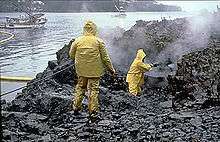Higg Index
The Higg Index is an apparel and footwear industry self-assessment standard for assessing environmental and social sustainability throughout the supply chain. Launched in 2012, it was developed by the Sustainable Apparel Coalition, a nonprofit organization founded by a group of fashion companies, the United States government Environmental Protection Agency, and other nonprofit entities.
Overview
The Higg Index provides a tool for the apparel and footwear industry to assess sustainability throughout a product's entire life cycle, from materials to end-of-life.[1] The metrics created Higg Index are limited to a company's internal use for the evaluation and improvement of environmental performance. Plans for a future version include the creation of a scoring scale designed to communicate a product's sustainability impact to consumers and other stakeholders.[2][3]
Version 1.0
Version 1.0 of the Higg Index was made public in July 2012.[4][5]
According to the Coalition's Executive Director, Jason Kibbey, the name "Higg" was inspired by the Higgs Boson search. The name Higg also met other key criteria: it was short, easy to pronounce and was able to clear trademark registration in 120 countries.[6]
In its first iteration, Higg Index metrics focus on environmental factors in the apparel supply chain. Metrics pertaining to footwear as well as labor and social sustainability are planned for a future release.[7]
Version 2.0
On 11 December 2013, an updated version of the Higg Index was released.[1]
Sustainable Apparel Coalition
The Sustainable Apparel Coalition is the developer of the Higg Index.[1] Founded in 2011, the Sustainable Apparel Coalition is a nonprofit organization whose members include brands producing apparel or footwear; retailers; industry affiliates and trade associations; the U.S. Environmental Protection Agency, academic institutions and environmental nonprofits.[8][9][10]
In October 2015, the Sustainable Apparel Coalition announced the launch of the Social Labor and Convergence Project, which seeks to establish a uniform standard for auditing labor conditions and social impact in the apparel and footwear industries.[11]
Predecessors
The first version of the Higg Index was adapted from two previously existing sustainability measurement standards: the Nike Apparel Environmental Design Tool and the Eco Index created by the Outdoor Industry Association, the European Outdoor Group and the Zero Waste Alliance.[12]
References
- 1 2 3 Friedman, Arthur (11 December 2013). "Higg Index Gets Updated". WWD. Retrieved 11 December 2013.
- ↑ Sustainable Apparel Coalition.<Clark, Evan. "Sustainability Index Unveiled", Women's Wear Daily, 25 July 2012. Retrieved on 20 December 2012.
- ↑ "The Higg Index". Retrieved on 20 December 2012.
- ↑ Clark, Evan. "Sustainability Index Unveiled", Women's Wear Daily, 25 July 2012. Retrieved on 20 December 2012.
- ↑ Binkley, Christina. "Which Outfit Is Greenest? A New Rating Tool", Wall Street Journal, 25 July 2012. Retrieved on 20 December 2012.
- ↑ Godelnik, Raz. "Interview: New Tool Will Measure Sustainability Across Apparel Supply Chain", TriplePundit, 27 July 2012. Retrieved on 20 December 2012.
- ↑ Reuben, Aaron. "Case Studies: The Higg Index for Sustainable Apparel", Environmental Performance Index, Yale Center for Environmental Law & Policy, 24 September 2012. Retrieved on 20 December 2012.
- ↑ "AAFA, SAC Sign MoU", Textile World Magazine, November/December 2012. Retrieved on 20 December 2012.
- ↑ Gunther, Marc. "Behind the Scenes at the Sustainable Apparel Coalition", GreenBiz, 26 July 2012. Retrieved on 20 December 2012.
- ↑ "Current Members", Sustainable Apparel Coalition. Retrieved on 20 December 2012.
- ↑ "Nike, Target, H&M and Others Joining Forces to Transform Global Labor Conditions". ehstoday.com. Retrieved 2015-10-27.
- ↑ Clark, Evan. "Sustainable Apparel Coalition Formed", Women's Wear Daily, 1 March 2011. Retrieved on 20 December 2012.
External Sources
- Sustainable Apparel Coalition
- Higg Index
- Sustainable Apparel Coalition Twitter feed @apprlcoalition
- Sustainable Apparel Coalition Facebook page
- Nike Environmental Design Tool
- The Eco Index
- Outdoor Industry Association Sustainability Working Group
- The European Outdoor Group
- Zero Waste Alliance
